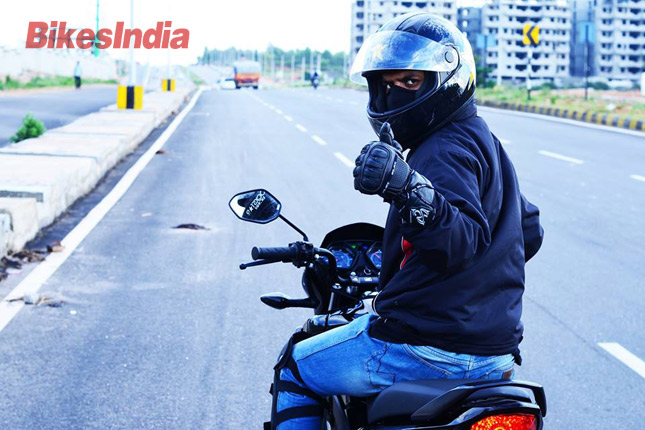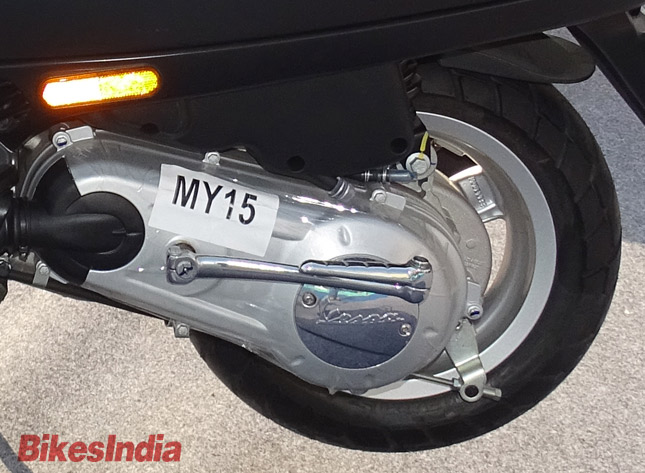Have you ever wondered why your 100cc scooter gives less mileage than your 100cc manual transmission bike? Think about it where a 100cc scooter returns mileage near 40-50 Kmpl, an average 100cc motorcycle provides mileage over 60 Kmpl. The answer to this question lies in the transmission used where the scooters use automatic CVT transmission, while motorcycles use a proper 4 or 5 speed manual transmission. So why does a CVT transmission return less fuel economy? Let’s check it out.
 The basic reason lies in the working on both the gears. In the manual transmission, the user selects the gear in which the bike runs, so the engine speed of the bike is in the hands of the rider. In case of a CVT transmission, the engine speed is always constant and the rider has nothing to control. So let’s consider that the engine means peak power and torque at 5000 RPM, then the CVT transmission will make sure that the engine speed remains at 5000 RPM at all times, no matter what. So if you happen to be puttering around at 20 kmph in the city, the scooter will still run at 5000 RPM. If you are doing speeds over 60 kmph, the scooter will still be doing 5000 RPM. That is how it works.
The basic reason lies in the working on both the gears. In the manual transmission, the user selects the gear in which the bike runs, so the engine speed of the bike is in the hands of the rider. In case of a CVT transmission, the engine speed is always constant and the rider has nothing to control. So let’s consider that the engine means peak power and torque at 5000 RPM, then the CVT transmission will make sure that the engine speed remains at 5000 RPM at all times, no matter what. So if you happen to be puttering around at 20 kmph in the city, the scooter will still run at 5000 RPM. If you are doing speeds over 60 kmph, the scooter will still be doing 5000 RPM. That is how it works.
READ ALSO: Continuously Variable Transmission (CVT) Explained
This is the advantage we have in manual transmission where we can putter around in higher gears, i.e. in the city we can simply go on 20 kmph at 2000 RPM on 3rd gear while on the highway still we can go at 60 kmph on 4th gear at somewhere near 5000 RPM. This is the reason why manual transmission has the mileage advantage as the fuel consumption at 5000 RPM will definitely be more than when the RPM is less than that. Hence you will find the scooters might sometimes even beat you at outright acceleration on the signals, but later you will definitely catch up when you reach higher RPM on top gear while they still go an at the same RPM range. This is also the reason why CVT transmission equipped scooters have a lower top speed than motorcycles of the same capacity.
Some might even argue that it is also because of the larger wheel size of the motorcycles while scooters have smaller wheels. Yes, it might be due to that as well, but again the bikes with manual transmission have a gearbox with a secondary drive on it to take care of the revolutions. On the other hand the CVT transmission scooters have direct belt drive. hence it does not really matter as much. Also scooters do not have an overdrive system like on motorcycles which bumps up fuel efficiency by a lot. Another main reason for the lower FE figures is because of the clutch used. The clutch is a centrifugal clutch used which engages and disengages automatically. In case of CVT transmission, there is no requirement of a clutch, but there is one provided when the scooter needs to be stopped or kept in an idle position. Hence whenever the gas is let off, the clutch engages leaving the engine running idle and consuming fuel unlike in manual transmissions. Here is where more fuel is consumed. On top of that the clutch is always in half engaged position hence the power transmission and efficiency is lost there too which results in more loss of efficiency.
Another main reason for the lower FE figures is because of the clutch used. The clutch is a centrifugal clutch used which engages and disengages automatically. In case of CVT transmission, there is no requirement of a clutch, but there is one provided when the scooter needs to be stopped or kept in an idle position. Hence whenever the gas is let off, the clutch engages leaving the engine running idle and consuming fuel unlike in manual transmissions. Here is where more fuel is consumed. On top of that the clutch is always in half engaged position hence the power transmission and efficiency is lost there too which results in more loss of efficiency.
Also in case of the clutch, the clutch is not controlled by the rider, it works automatically, and the clutch is also a pretty inefficient unit which draws its power from none other than the engine. This results in more loss of power and to make that up in terms of performance, the efficiency of the scooter takes a hit.
So all these reasons combined is what results in a lower efficiency of scooters. Yes there are many advantages to CVT transmission scooters, but this is one huge drawback. But yet people do not seem to be much hindered about it as they are fine with compromising a bit in terms of efficiency for the ease of ride. But now technology is developing in terms of CVT and we hope that soon this efficiency figures will come close and the gap comes to almost NIL. Until then we will have to go about it the way it is.
By: Pratik Patole
 The basic reason lies in the working on both the gears. In the manual transmission, the user selects the gear in which the bike runs, so the engine speed of the bike is in the hands of the rider. In case of a CVT transmission, the engine speed is always constant and the rider has nothing to control. So let’s consider that the engine means peak power and torque at 5000 RPM, then the CVT transmission will make sure that the engine speed remains at 5000 RPM at all times, no matter what. So if you happen to be puttering around at 20 kmph in the city, the scooter will still run at 5000 RPM. If you are doing speeds over 60 kmph, the scooter will still be doing 5000 RPM. That is how it works.
The basic reason lies in the working on both the gears. In the manual transmission, the user selects the gear in which the bike runs, so the engine speed of the bike is in the hands of the rider. In case of a CVT transmission, the engine speed is always constant and the rider has nothing to control. So let’s consider that the engine means peak power and torque at 5000 RPM, then the CVT transmission will make sure that the engine speed remains at 5000 RPM at all times, no matter what. So if you happen to be puttering around at 20 kmph in the city, the scooter will still run at 5000 RPM. If you are doing speeds over 60 kmph, the scooter will still be doing 5000 RPM. That is how it works.READ ALSO: Continuously Variable Transmission (CVT) Explained
This is the advantage we have in manual transmission where we can putter around in higher gears, i.e. in the city we can simply go on 20 kmph at 2000 RPM on 3rd gear while on the highway still we can go at 60 kmph on 4th gear at somewhere near 5000 RPM. This is the reason why manual transmission has the mileage advantage as the fuel consumption at 5000 RPM will definitely be more than when the RPM is less than that. Hence you will find the scooters might sometimes even beat you at outright acceleration on the signals, but later you will definitely catch up when you reach higher RPM on top gear while they still go an at the same RPM range. This is also the reason why CVT transmission equipped scooters have a lower top speed than motorcycles of the same capacity.
Some might even argue that it is also because of the larger wheel size of the motorcycles while scooters have smaller wheels. Yes, it might be due to that as well, but again the bikes with manual transmission have a gearbox with a secondary drive on it to take care of the revolutions. On the other hand the CVT transmission scooters have direct belt drive. hence it does not really matter as much. Also scooters do not have an overdrive system like on motorcycles which bumps up fuel efficiency by a lot.
 Another main reason for the lower FE figures is because of the clutch used. The clutch is a centrifugal clutch used which engages and disengages automatically. In case of CVT transmission, there is no requirement of a clutch, but there is one provided when the scooter needs to be stopped or kept in an idle position. Hence whenever the gas is let off, the clutch engages leaving the engine running idle and consuming fuel unlike in manual transmissions. Here is where more fuel is consumed. On top of that the clutch is always in half engaged position hence the power transmission and efficiency is lost there too which results in more loss of efficiency.
Another main reason for the lower FE figures is because of the clutch used. The clutch is a centrifugal clutch used which engages and disengages automatically. In case of CVT transmission, there is no requirement of a clutch, but there is one provided when the scooter needs to be stopped or kept in an idle position. Hence whenever the gas is let off, the clutch engages leaving the engine running idle and consuming fuel unlike in manual transmissions. Here is where more fuel is consumed. On top of that the clutch is always in half engaged position hence the power transmission and efficiency is lost there too which results in more loss of efficiency.Also in case of the clutch, the clutch is not controlled by the rider, it works automatically, and the clutch is also a pretty inefficient unit which draws its power from none other than the engine. This results in more loss of power and to make that up in terms of performance, the efficiency of the scooter takes a hit.
So all these reasons combined is what results in a lower efficiency of scooters. Yes there are many advantages to CVT transmission scooters, but this is one huge drawback. But yet people do not seem to be much hindered about it as they are fine with compromising a bit in terms of efficiency for the ease of ride. But now technology is developing in terms of CVT and we hope that soon this efficiency figures will come close and the gap comes to almost NIL. Until then we will have to go about it the way it is.
By: Pratik Patole











